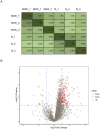New biomarkers of Kawasaki disease identified by gingival crevicular fluid proteomics
- PMID: 40421421
- PMCID: PMC12104053
- DOI: 10.3389/fmolb.2025.1597412
New biomarkers of Kawasaki disease identified by gingival crevicular fluid proteomics
Abstract
Introduction: Kawasaki disease (KD) is an acute systemic vasculitis that primarily affects coronary arteries, and delayed diagnosis increases the risk of cardiovascular complications. Biomarkers are essential for improving diagnostic accuracy, especially in atypical cases. Gingival crevicular fluid (GCF), derived from periodontal tissues, contains serum components and inflammatory mediators, and has emerged as a valuable biofluid for systemic disease diagnosis. Previous studies suggest GCF protein profiles reflect immune status and metabolic disorders, such as type 2 diabetes. Given the immune-related nature of KD, GCF protein composition may also be altered, yet no studies have systematically explored GCF biomarkers in KD. This study uses DIA and MRM-MS proteomics to identify potential GCF biomarkers for KD diagnosis.
Methods: Twenty-seven patients with KD were enrolled in this study, and 18 healthy volunteers were recruited as the control group. GCF samples were collected from the KD patients, who formed the experimental group, before they received intravenous immunoglobulin treatment. Data-independent acquisition (DIA) quantitative proteomics mass spectrometry was performed on the GCF samples to analyze the protein expression profiles in both groups. DEPs were identified and subjected to functional enrichment analysis using KEGG and GO. Protein-protein interaction (PPI) analysis was conducted for all detected DEPs. Finally, multiple reaction monitoring mass spectrometry (MRM-MS) was used to validate the selected DEPs.
Results: A total of 197 DEPs were identified in GCF between the KD group and the normal control group, with 174 upregulated and 23 downregulated proteins. Functional enrichment analysis revealed that cellular and metabolic processes were the most significantly altered biological processes, while binding and catalytic activity were the most affected molecular functions. Pathway analysis further highlighted the NOD-like receptor signaling pathway, protein processing in the endoplasmic reticulum, and the influenza pathway as the most significantly enriched pathways. In the PPI network, EIF2AK2, B2M, and GBP1 were identified as key hub proteins, suggesting their potential regulatory roles in KD pathophysiology. Finally, MRM-MS confirmed the expression patterns of 12 DEPs (IFIT3, UB2L6, HP, A1AT, HSP90AA1, HNRPC, HSP90AB1, SAA1, MX1, B2M, FKBP4, and TRAP1), thereby demonstrating high consistency with the DIA results and further validating the DEPs' potential as biomarkers for KD.
Conclusion: Our findings suggest that 12 proteins in GCF could serve as potential biomarkers for the early diagnosis of KD. Additionally, the molecular analysis revealed a close association between KD and gingival inflammation, offering new insights into KD's pathophysiology and potential directions for improved diagnosis and treatment.
Keywords: Kawasaki disease; bioinformatics analysis; coronary artery lesions; gingival crevicular fluid; proteomics.
Copyright © 2025 Fan, Li, Xu, Lin, Guo, Liao and Xu.
Conflict of interest statement
The authors declare that the research was conducted in the absence of any commercial or financial relationships that could be construed as a potential conflict of interest.
Figures





Similar articles
-
Quantitative proteomic analysis of gingival crevicular fluids to identify novel biomarkers of gingival recession in orthodontic patients.J Proteomics. 2022 Aug 30;266:104647. doi: 10.1016/j.jprot.2022.104647. Epub 2022 Jun 30. J Proteomics. 2022. PMID: 35779762
-
Plasma Exosomal-Derived SERPINA1 and GNAI2 Downregulation as Potential Diagnostic Biomarkers of Kawasaki Disease with Coronary Artery Aneurysms.Int J Mol Sci. 2025 Mar 16;26(6):2668. doi: 10.3390/ijms26062668. Int J Mol Sci. 2025. PMID: 40141310 Free PMC article.
-
New biomarkers of Kawasaki disease identified by urine proteomic analysis.FEBS Open Bio. 2018 Dec 20;9(2):265-275. doi: 10.1002/2211-5463.12563. eCollection 2019 Feb. FEBS Open Bio. 2018. PMID: 30761252 Free PMC article.
-
Current Status of Proteomic Technologies for Discovering and Identifying Gingival Crevicular Fluid Biomarkers for Periodontal Disease.Int J Mol Sci. 2018 Dec 26;20(1):86. doi: 10.3390/ijms20010086. Int J Mol Sci. 2018. PMID: 30587811 Free PMC article. Review.
-
Analysis of gingival crevicular fluid as applied to the diagnosis of oral and systemic diseases.Ann N Y Acad Sci. 2007 Mar;1098:216-29. doi: 10.1196/annals.1384.027. Ann N Y Acad Sci. 2007. PMID: 17435131 Review.
References
-
- Chaparro A., Sanz A., Quintero A., Inostroza C., Ramirez V., Carrion F., et al. (2013). Increased inflammatory biomarkers in early pregnancy is associated with the development of pre-eclampsia in patients with periodontitis: a case control study. J. Periodontal Res. 48 (3), 302–307. 10.1111/jre.12008 - DOI - PubMed
LinkOut - more resources
Full Text Sources
Research Materials
Miscellaneous

